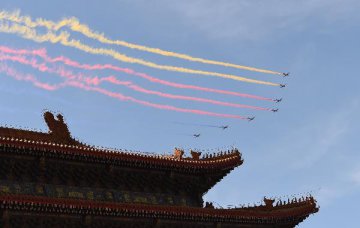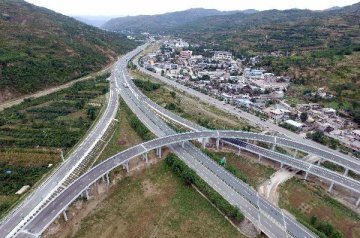
China’s fiscal revenue increased 3.7 percent year on year to 1,607.3 billion yuan in May, according to data released by the Ministry of Finance (MOF) on June 12. Specifically, the central government saw fiscal revenue down 3.6 percent year on year to 795.1 billion yuan, while local governments saw fiscal revenue expand 12 percent to 812.2 billion yuan.
It is noteworthy that tax revenue came at 1,410.2 billion yuan, up 6.4 percent year on year; while non-tax revenue came at 197.1 billion yuan, down 12.5 percent year on year.
The MOF explained that the relatively low growth rate in May mainly attributes to the slowdown of related economic indicators, continued tax breaks and a high base a year ago.
Professor Feng Qiaobin from Chinese Academy of Governance told the National Business Daily that the decline in non-tax revenue is consistent with China’s target to regulate non-tax revenue.
Non-tax revenue down 12.5 pct. y-o-y
The MOF predicted as early as in April that the growth in fiscal revenue may continue to slow down due to the slowdown of related economic indicators, continued tax break
The country’s fiscal revenue increased 3.7 percent year on year to 1,607.3 billion yuan in May, while it expanded 7.8 percent in April. In May, the tax revenue was 1,410.2 billion yuan, up 6.4 percent year on year; while non-tax revenue was 197.1 billion yuan, down 12.5 percent year on year.
The reporter noticed that the State Council issued measures to cut taxes and administrative fees five times in nearly 3 months in order to cut one trillion yuan taxes and administrative fees for enterprises this year. While introducing measures to reduce 200 billion yuan administrative fees in the first quarter, the executive meeting of the State Council also deployed six measures to cut taxes. It is expected that it will save over 380 billion yuan taxes for market participants.
Vice-minister of finance Shi Yaobin said at a regular briefing of the State Council on June 9 that in order to cut tax, the MOF has streamlined the structure of value-added tax and expanded the scope of small low-profit enterprises that can enjoy favorable income tax. As for administrative fees reduction, the MOF introduced policies to clear and regulate fees concerning enterprises, reduce unemployment insurance rate, improve Internet speed and reduce enterprises’ energy costs.
Changjiang Securities noted in a research report that cutting taxes and administrative fees has made some impact on the structure of fiscal revenue. This can be seen in the decline in the proportion of non-tax revenue. In the first four months this year, the proportion of non-tax revenue has decreased 3.7 percentage points to 14.6 percent compared to the end of last year.
The report shows that the policies introduced to cut taxes and administrative fees will mainly benefit small businesses this year, and will help middle and downstream and export-oriented small businesses to improve their profitability.
While easing enterprises’ tax burden, cutting taxes and administrative fees will also facilitate enterprises to transform and upgrade, thus driving economy growth via increasing private investment, accelerating restoring of the manufacturing industry, promoting corporate and household consumption and improving enterprises research and development ability.
Fields concerning people’s livelihood maintain high growth
The National Business Daily noticed that the growth rate of fiscal revenue in May fall to the lowest level in the year.
However, the growth of fiscal expenditures did not slow down. Data shows that fiscal expenditure was up 9.2 percent year on year to 1.69 trillion yuan. Specifically, the central government recorded a fiscal expenditure of 272.4 billion yuan, up 5.8 percent year on year; while local governments recorded a fiscal expenditure of 1,419.1 billion yuan, up 9.8 percent year on year.
The research report shows that as a whole, thanks to a remarkable recovery in earning performance of enterprises, this year’s fiscal revenue will improve, while measures to cut taxes and fees might have limited impact on government’s spending capacity. A preliminary estimation suggests that even if factoring in the impact of these measures, the growth rate of fiscal revenue for the full year in a neutral situation is likely to reach above 10 percent (that recorded 4.5 percent last year, and 14.1 percent in the first quarter this year).
In view of major expenditure items, expenditures in many key fields concerning people’s livelihood maintained double-digit growth. The cumulative fiscal expenditures from January to May came at 7,646.7 billion yuan, of which expenditures in housing security were 227.6 billion yuan, up 23 percent; that in social security and employment were 1,179.1 billion yuan, up 21.2 percent; that in medical, health and family planning were 645.4 billion yuan, up 17.6 percent; that in education were 1,134.7 billion yuan, up 14.3 percent.
Feng Qiaobin believed that fiscal spending in key areas concerning people’s livelihood and growth stabilization should maintain growth in the future. It should also adjust the structure of fiscal revenues and expenditure to improve the usage efficiency of funds.
Huatai Securities analyst Xu Yang believed that based on the current situation, China can consider adopting stable and neutral monetary policy to maintain liquidity in the economy and to prevent sharp fluctuation in the process of deleveraging. Meanwhile, it can also provide other public goods, such as health care, education, in addition to infrastructure via fiscal policy, which will be more meaningful to stabilizing growth.
Translated by Coral Zhong





















Latest comments